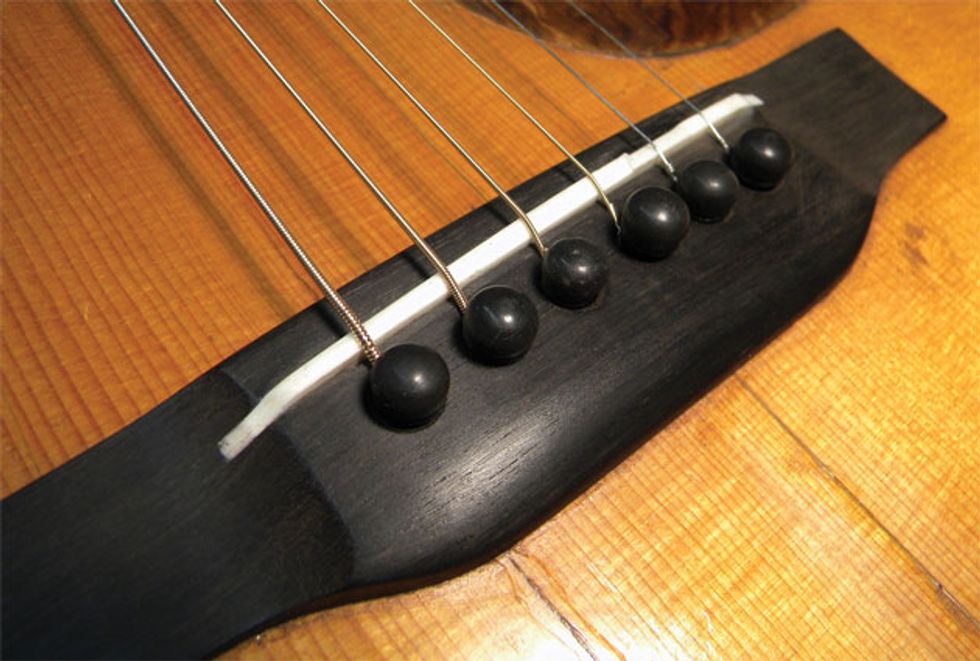You tune your banjo perfectly. You play a few chords and discover that as you move up the neck that the banjo starts to sound dramatically out of tune. You check again and the tuning is good. What is going on? A great place to start is the intonation of your banjo.
A few days ago, a customer called me in despair. She had purchased one of our Goodtime Six banjos about 9 months ago and had never been able to get it to stay in tune.
Concerned, I began asking some questions; are the tuners slipping? This I knew would be very unlikely given the quality of our Goodtime tuners, but it was the right place to start. Was she using an odd brand of strings? She confirmed that she was using Deering's 6-string set, so that too was fairly unlikely to be the cause.
I could sense the customer was an experienced player, but not so experienced in the technical physics of stringed instruments and how to maintain them. The customer then mentioned that she was frustrated because she was successfully tuning each string perfectly to pitch, but it "sounded" out of tune when she played. This led me to believe that poor intonation was at play.
Intonation is a tricky thing to define, but it essentially refers to the instrument being in tune with itself, as your fret up the neck. The physics involve the position of the bridge in relation to the overall length of the string, otherwise known as "scale length". 
If you tune each individual banjo string to the correct pitch, you should be able to play various chords and they will sound good. They will sound in harmony with one another. This is a good sign that the banjo is properly intonated.
However, other times when you tune up the chords sound terrible, particularly the further up the neck you play. This is normally a sign that the intonation is out, meaning that the bridge is not placed correctly and needs attention.
It is important to remember that intonation is not an issue exclusive to banjo. Nearly all stringed instruments work off the same principles.
Your banjo has a floating bridge, meaning that it is not fixed to the head. It simply remains in place under tension from the strings. This is good and bad. It does mean that if the bridge is knocked (which is actually much harder to do than you might think), the intonation can go out a little easier. In contrast, it also means that you can adjust the intonation quickly, easily and without any tools.
Electric guitars and bases often have metal bridges that incorporate individual "saddles" which can be adjusted back and forth. This means intonation for each string can be adjusted independently from one another. Very handy, but only if you have the right tools to hand.

Acoustic guitars have fixed wooden bridges, with saddles installed, so there is no real way to adjust intonation. Again, this is good and bad, in the sense that there is less adjustments to worry about. But there is also less adjustments. Period.

So the banjo blends a combination the different styles; while it doesn't have the flexibility of allowing for independent string adjustments, it can be adjusted easily and quickly, without the need for tools. Once you understand the principle of adjusting intonation, the rest of the battle is how easy it is to do.
When you string your banjo, the "scale length" refers to the distance between the inside of the nut, all the way to the bridge. If you don't know where your bridge should go, you can quickly calculate your scale length quickly by measuring from the inside of the nut to the center of the twelfth fret, and then doubling it.
To adjust your intonation, use a tuner and play your string open and make sure it is in tune. Then play the same string while fretting the twelfth fret. If it is sharp, it means the bridge is too far forward and should be moved backwards slightly. By doing so, you are essentially lengthening the string. If it is flat, it means your bridge needs to move closer to the neck, so shortening the length of the string. Make the adjustment, by lifting the bridge and carefully moving it in the direction it should go. Re-tune and check again.
If you know that your bridge is in the exact position that it should be, there may be other causes. Old strings will make your banjo sound dull, but they can also affect the way it intonations, so always make sure your strings are fresh. Check out our article on how to change strings.
Another area to look into is technique, specifically pressing too hard when fretting. This eventually causes fret wear which can have an affect on intonation also.
Thanks for reading.
Changing your banjo strings is one of the easiest and best ways to bring the tone of your banjo back to life. One of the most common questions we hear is how...
Modern banjos have standard head sizes. Vintage banjos on the other hand have head sizes that are all over the map. At Deering we use two different head...
In this informative video, Deering Quality Control Manager, Chad Kopotic, shares his expertise on setting up a banjo tailpiece, specifically focusing on the...
3733 Kenora Dr.
Spring Valley, CA 91977
COMMENTS